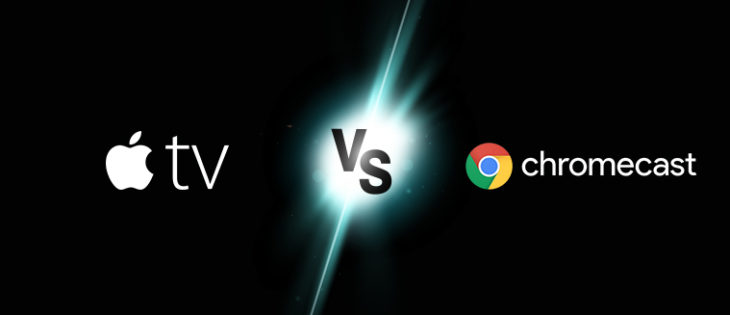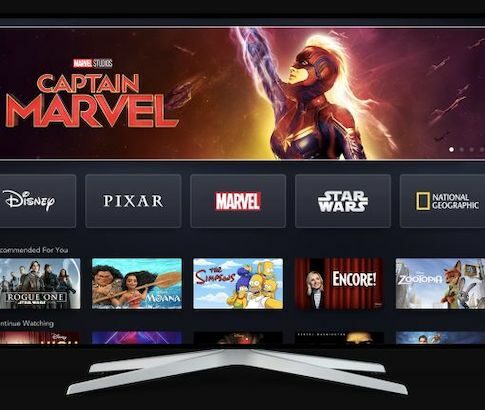
Updated on 1st October 2020
Google’s won itself a lot of friends with its affordable, deceptively simple streaming Chromecast dongles. So can it possibly be worth spending two to four times the money on Apple’s solution to the booming streaming market — the Apple TV? Read on to find out!
What are the differences between Apple TV and Google Chromecast?
These are the two veterans of the home TV streaming world — classic devices that have taken on all challengers and still managed to stay at the top of their game as go-to options for anyone wanting to get the streaming video onto their big-screen TV. But in a world which now has many other stand-alone device options — as well as smart TVs that can do it all — how do these two classics measure up? And are they still worth buying?
Apple TV vs Google Chromecast
On the surface, it would seem to be a somewhat unfair face-off — and a slightly more complex one than usual. For starters, we’re talking about two very different kinds of streaming devices here. Apple’s is a conventional tiny black box, designed as a “source device” for your TV in much the same way that a pay-TV box or a PVR might be — you interface with the box via an on-screen interface, and get it to run a variety of apps for you to do the stuff you want to do. Google’s device is very different — and is still almost unique in its simplicity. Its smarts are all packed into a tiny plastic dongle that hides behind your TV and feeds it video. It doesn’t run “apps” in the way we usually know them — instead, you run the apps on your smartphone or tablet, and use them to control playback on the device.
But what seems like an unfair fight is actually not so black and white. There’s innate flexibility with Google’s way of doing things that Apple can’t quite match. But to appreciate it, you’ve got to be willing to accept a complete change from the usual way of doing things — a change where your smartphone doubles as a remote control, with all the extra complexity that brings.
Google’s 2020 Chromecast – A Different Story
For over half a decade since it first launched, the various models of Chromecast have all been exactly as described above – small devices that plug into a spare HDMI port and let you stream to them from your phone, tablet or PC. They didn’t run apps at all, relying on you downloading the apps you use to your own devices first, then sending video to the Chromecast over your wi-fi network.
With the release of the new Chromecast with Google TV in October 2020, though, the game has changed – and so has the comparison with Apple TV. Now, Google’s little streaming dongle comes with a remote control, and has its own on-screen user interface that’s based on the latest version of Android TV (the operating system used by most Sony TVs, as well as some streaming devices like the Foxtel Now box).
This lets you download apps to the Chromecast from Google’s app store in the same way you would do so on an Apple TV, and you can browse apps on-screen the same way as well. The remote control has a built-in microphone – just like Apple’s Siri remote – and a button to let you issue commands or ask questions via Google Assistant. It’ll even let you control cameras, lights and other smart home devices from your TV using your voice, similar to the way Apple’s HomeKit does on Apple TV.
It’s a very, very capable device – and the really good news is the price. While an Apple TV 4K starts at $249, Google’s new Chromecast, with its support for 4K, Dolby Vision, Dolby Atmos, and more, costs just $99. More than ever, it’s a very real alternative to Apple TV – though of course, if you’ve already got content you’ve bought on Apple’s iTunes movie and TV stores, or if you use Apple’s TV+ streaming service, at the moment you can’t access any of that on Google’s new Chromecast.
How much does Apple TV cost?
This is really a comparison between two devices from each company, as well — what you’ll want depends on whether or not you have a TV that can display 4K video (and a fast enough broadband connection to stream it). Apple’s 4th-generation Apple TV, limited to 1080p video, is still a current product, now priced at $209. The newer Apple TV 4K, meanwhile, starts at $249.
How much does Google Chromecast cost?
Google, meanwhile, now maintains three versions of its Chromecast. The standard 1080p-capable model can be had for as little as $59, while the 4K-ready Chromecast Ultra (which we reviewed here at launch) spikes the price up to $99 – now likely to be discounted heavily following the release of the 2020 Chromecast, with all of its new features, coming in at that same $99 price point. As you can see, in price terms, Google’s got the upper hand by a long way. Does the Apple TV offer enough to make the huge price gap worth it?
What’s the difference between the operating systems? Apple TV vs Google Chromecast
Apple iOS and tvOS
We’re in “night and day” territory here, to an extent, because while you control Google Chromecast from a plethora of conventional apps on your smartphone or tablet, Apple TV runs its own special breed of apps. While it does operate on a version of iOS (not surprisingly called tvOS) and has the guts of an iPad Pro as its core smarts, it can’t just run any streaming app you happen to have on your iDevice.
Instead, apps have to be especially crafted for tvOS, even though they can be (and usually are) distributed as part of the same download package as the corresponding iPhone app. So, for example, if you grab ABC iView from the App Store on your phone, a tvOS version will automatically download to your Apple TV, ready to run on the big screen.
Google Casting
Compare that to Chromecast, where all that’s needed is for casting support to be added to any streaming app, and then it’s usable on the little Google device. You just run the app on your phone or tablet, tap the “cast” icon at top right, start playback, and the video appears on your TV. It’s simple and effective, and the ease of adding Chromecast support to apps means there are literally thousands of apps out there that’ll work with the device.
The 2020 Chromecast adds the ability to load apps directly on the device, just like Apple TV – but you can also cast to it from any Chromecast-compatible app on your phone or tablet.
 Featured
FeaturedApple Streaming
Apple’s on-screen interface gives them the upper hand with apps that aren’t about streaming — such as games, utilities like weather apps and so on. And of course, they make the most of the seamless screen support with services like Apple Music, blending music video playlists with straight audio ones.
What is the difference between User Experience? Apple TV vs Google Chromecast
Using Google Chromecast
The need to control the Chromecast from a separate smart device is both its best and worst feature. Initially, it’s easy to miss the presence of a dedicated remote control and curse the need to unlock your phone and navigate around a touch screen just to change what’s playing, or to run a different app. But soon you start to realise how incredibly flexible it is, letting you send just about anything to your big-screen TV — including not just streaming video services, but also photo galleries, personal videos, websites, the sky’s the limit. Friends, family and guests can all join in too if you choose to open access to anyone on your home network.
All of this is still possible with the 2020 Chromecast, but now, with the on-screen interface and supplied remote control, you’ll likely be using it much more like you would the Apple TV, navigating apps and streaming video without the need for a device to cast from.
Using Apple TV
Apple TV’s remote is a tiny, rechargeable little device (battery life is a good 6 to 9 months between charges) which can be initially annoying with the glass trackpad it uses as the main way of communicating with the box. It takes a fair bit of getting used to, but once you do, you start to think less of all those old-fashioned clicky-clicky remotes. Speaking of which, you can use one of those for the Chromecast if you really want to — and as long as your TV supports HDMI CEC — but it’s limited to pausing what’s currently playing or changing the volume.
Power Saving
Left idle, Chromecast cycles through a bunch of images from Google along with basics like the current time and the weather. You can replace the photos with your own if you like, though they have to be in a Google Photos album and added via the official Google Home app that’s used to do all the device’s setup. Apple TV’s idle mode defaults to the full-motion “Aerial” screensaver, a large collection of high quality “flyover” videos shot in 4K from drones (and in the case of the latest ones, from space and under the sea!) There’s no finer wallpaper for your shiny new TV.
Chromecast Support
When it comes to the classic Chromecasts, the interface you use is whatever interface your current Chromecast-supporting app has — there’s no interactive on-screen interface at all aside from a simple “fuel gauge” progress bar. Any setup or settings you need to change on Chromecast can only be done from the free Google Home app. That’s the same app you use for a Google Home smart speaker, and there’s a reason for that — Chromecast can be controlled by your Google Home if you have one.
On the 2020 model, you control the Chromecast via its new on-screen Google TV interface, based on the popular Android TV operating system. Or, if you want to go old-school, you can still cast to it!
Using Siri
Apple TV’s interface is simple, elegant, liquid-smooth and instantly understandable, and while it falls back on the traditional “screen full of icons” approach, it’s well done and, if you really want, can be almost entirely replaced by voice commands to the in-built Siri via the mic on the remote control. Both Apple TV variants are suitably overpowered for the tasks asked of them, and so you’re never left waiting for a thing.
What about Paid Content and Search?
This one comes down to a choice — for your bought and rented TV and movies — between Apple’s iTunes Store and Google’s Play Movies store, assuming what you’re after is the standard selection of new and classic paid content (almost identical between the two platforms). Apple’s store, however, offers movies in 4K with enhancements like Dolby Vision, HDR and Dolby Atmos; Google offers none of these.
Additionally, there are other paid providers that have apps to work with both platforms, but these are the two biggest digital content stores in the business, so they’ll be your first port of call.
Search is a clear victory to Apple TV — it’s superb integration of Siri allows voice search across multiple stores and apps, so you can ask for “movies with Johnny Depp” and get a list of films on iTunes Store, Netflix, Stan and others to pick from. With Chromecast, meanwhile, finding stuff is entirely up to you and your apps, though the 2020 model’s addition of Google Assistant promises to level the playing field when it comes to search.
Which Offers Best Value for the Money?
Ultimately, it’s a tough call — because these are devices that set out to do a similar thing but end up giving you completely different experiences. There’s absolutely no denying the excellent value that Google’s Chromecast represents. It works with just about every app under the sun, it’s a set-and-forget thing that sits behind your TV but can be taken with you easily if you go on a trip, and its standard version is one of the cheapest streaming devices on the market.
Apple TV, meanwhile, is more of a “luxury” option. Most (but not all) of what it does can be done by cheaper devices, but none of them does it quite as well or with such a meticulous focus on technical quality. Everything from interface to app design feels comfortable and friendly, it’s supported by more streaming services and TV networks than any comparable device, and if you really want to, you can cast to it from an iOS device using AirPlay, allowing for social video and photo sharing.
They’re both superb choices, but if you can bear the not-insignificant price, Apple TV remains the best streaming device on the market, hands down. However with its new 2020 Chromecast at less than half the price, Google’s stepped up the competition massively.






















